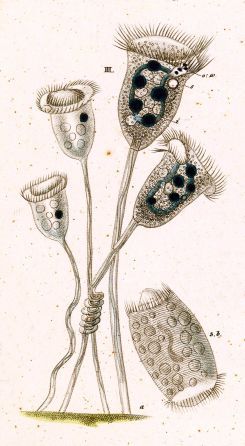Vorticella
A genus of protozoan ciliates
Vorticella is a genus of protozoa belonging to the phylum Ciliophora. These organisms are characterized by their bell-shaped bodies and stalks that attach to substrates in aquatic environments. Vorticella species are commonly found in freshwater habitats, where they play a role in the ecosystem as filter feeders.
Morphology[edit | edit source]
Vorticella are known for their distinctive morphology. The body, or zooid, is bell-shaped and contains a ring of cilia around the oral region. These cilia are used for feeding and locomotion. The stalk, which is contractile, attaches the organism to a substrate. The contraction of the stalk is a rapid response to stimuli, allowing the organism to retract quickly.
The cell body contains a large macronucleus and one or more micronuclei, typical of ciliates. The cytoplasm is divided into ectoplasm and endoplasm, with the ectoplasm containing the ciliary structures and the endoplasm housing the organelles.
Feeding and Behavior[edit | edit source]
Vorticella are filter feeders, using their cilia to create water currents that draw in food particles, such as bacteria and small protozoans. The food is directed into the oral cavity and then into the cytostome, where it is engulfed into food vacuoles for digestion.
The stalk of Vorticella is a unique feature that allows it to anchor to surfaces while feeding. The stalk contains a contractile fibril called the myoneme, which enables rapid contraction and extension. This mechanism is used for protection and repositioning.
Reproduction[edit | edit source]
Vorticella reproduce both asexually and sexually. Asexual reproduction occurs through binary fission, where the organism divides transversely. During this process, the stalked parent cell divides to produce a free-swimming daughter cell, which eventually settles and forms its own stalk.
Sexual reproduction involves conjugation, a process where two individuals exchange genetic material. This process increases genetic diversity and is common among ciliates.
Ecological Role[edit | edit source]
Vorticella play an important role in aquatic ecosystems as part of the microbial loop. By feeding on bacteria and small particles, they help recycle nutrients and maintain water quality. They are also a food source for larger organisms, contributing to the aquatic food web.
Related pages[edit | edit source]
Search WikiMD
Ad.Tired of being Overweight? Try W8MD's physician weight loss program.
Semaglutide (Ozempic / Wegovy and Tirzepatide (Mounjaro / Zepbound) available.
Advertise on WikiMD
|
WikiMD's Wellness Encyclopedia |
| Let Food Be Thy Medicine Medicine Thy Food - Hippocrates |
Translate this page: - East Asian
中文,
日本,
한국어,
South Asian
हिन्दी,
தமிழ்,
తెలుగు,
Urdu,
ಕನ್ನಡ,
Southeast Asian
Indonesian,
Vietnamese,
Thai,
မြန်မာဘာသာ,
বাংলা
European
español,
Deutsch,
français,
Greek,
português do Brasil,
polski,
română,
русский,
Nederlands,
norsk,
svenska,
suomi,
Italian
Middle Eastern & African
عربى,
Turkish,
Persian,
Hebrew,
Afrikaans,
isiZulu,
Kiswahili,
Other
Bulgarian,
Hungarian,
Czech,
Swedish,
മലയാളം,
मराठी,
ਪੰਜਾਬੀ,
ગુજરાતી,
Portuguese,
Ukrainian
Medical Disclaimer: WikiMD is not a substitute for professional medical advice. The information on WikiMD is provided as an information resource only, may be incorrect, outdated or misleading, and is not to be used or relied on for any diagnostic or treatment purposes. Please consult your health care provider before making any healthcare decisions or for guidance about a specific medical condition. WikiMD expressly disclaims responsibility, and shall have no liability, for any damages, loss, injury, or liability whatsoever suffered as a result of your reliance on the information contained in this site. By visiting this site you agree to the foregoing terms and conditions, which may from time to time be changed or supplemented by WikiMD. If you do not agree to the foregoing terms and conditions, you should not enter or use this site. See full disclaimer.
Credits:Most images are courtesy of Wikimedia commons, and templates, categories Wikipedia, licensed under CC BY SA or similar.
Contributors: Prab R. Tumpati, MD

